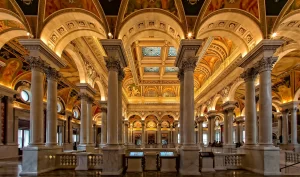The arcade is an important feature of Ottonian architecture, a style that was influential in Europe during the 10th and 11th centuries. This architectural style drew its inspiration from Carolingian and Byzantine styles, as well as Germanic traditions, to form a unique amalgamation of features. As such, the arcade played a major role in the construction of churches and other religious buildings.
An arcade is a series of arches that are connected by columns or piers. The idea was to create an open space beneath the arches, which allowed light to enter the building. This was a common feature in Romanesque architecture and it carried over into Ottonian style as well.
The Ottonian architects typically used semicircular arches for their arcade designs, although they could also incorporate pointed arches or even flat surfaces. The width of the arcade varied from building to building, depending on the size and shape of the space available.
By using an arcade in churches, Ottonian architects were able to create large open spaces with the support of arches and columns. This allowed them to create grandiose entranceways and central areas that could accommodate large numbers of worshippers. The arcade also served as a form of decoration, providing an ornamental element to the building’s architecture.
Today, Ottonian arcades can still be seen in places like Germany and Italy. They are an important element of the history of European architecture, as they show the skill and creativity of architects during this period. The arcade has remained a popular feature in religious buildings throughout the ages, and it serves to demonstrate the importance of innovation in architecture.
The Ottonian architects were not only skilled in the use of arcades, they also created structures such as triforia and tribunes. These features allowed for more light to enter the building and gave it a two-level effect. Triforia are galleries that were often placed above an arcade so that the upper level could be seen from the ground floor. Tribunes are large balconies, usually located at the back of a church, that were used to display religious works of art or other ornamentation. Together, these features allowed Ottonian architects to create grand and impressive religious buildings.

The arcade was an important feature of Ottonian architecture, and it continues to be a popular design element in churches today. The skill and creativity that went into the construction of these arcades is a testament to the talents of medieval architects during this period. Although the style has changed over time, its influence can still be seen in many of today’s churches.
In conclusion, the arcade played a major role in Ottonian architecture, both from an aesthetic and structural point of view. It allowed architects to create large open spaces that could accommodate numerous worshippers, as well as providing an ornamental element to the building’s design. The arcade remains an important feature in religious structures today, and its legacy can be seen in many of the grand churches that still grace our landscape.

